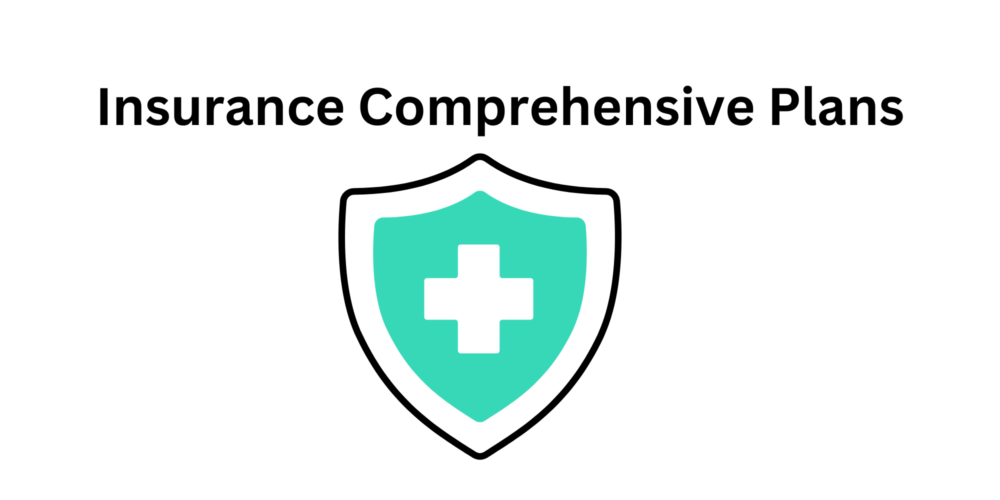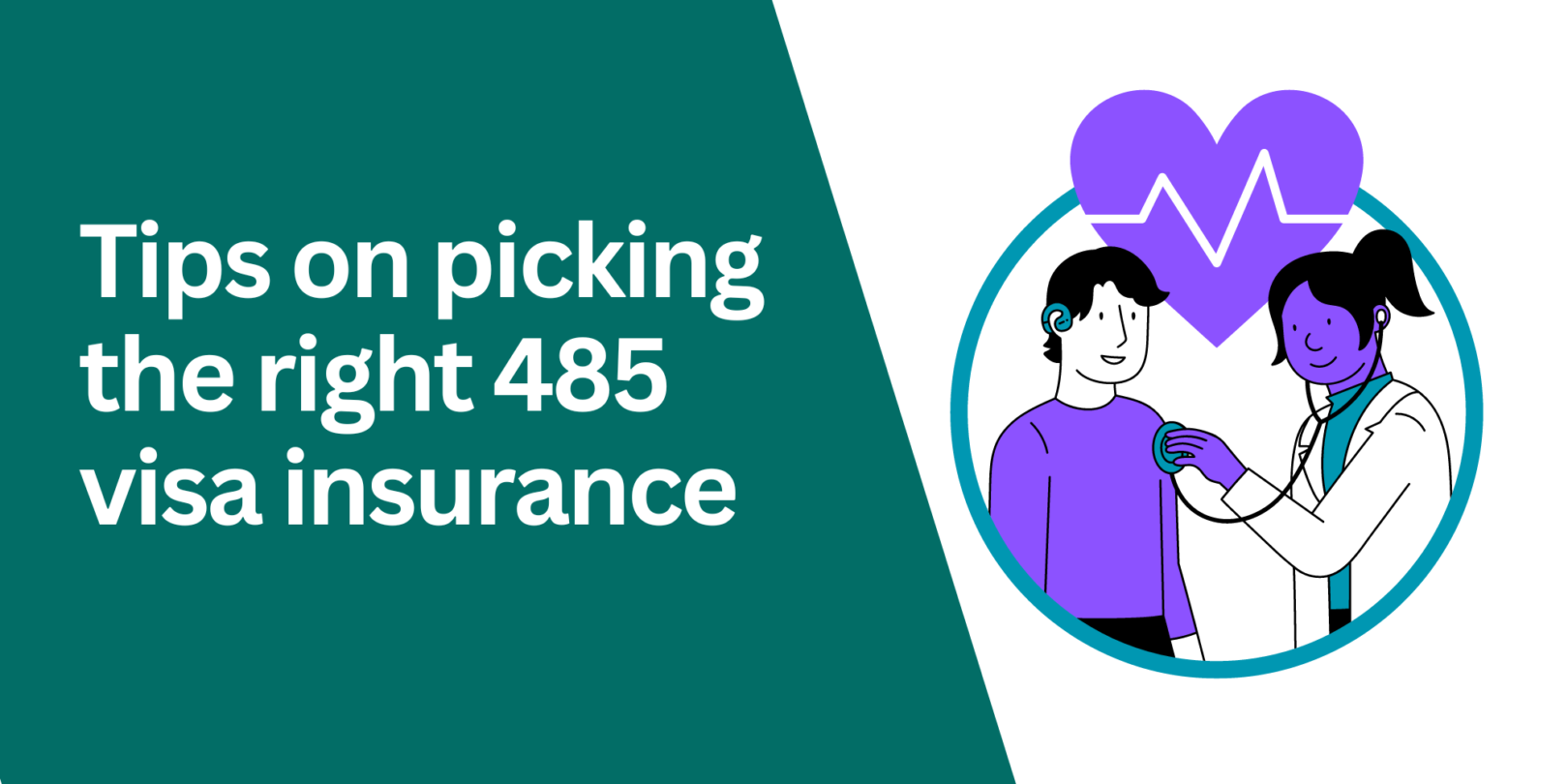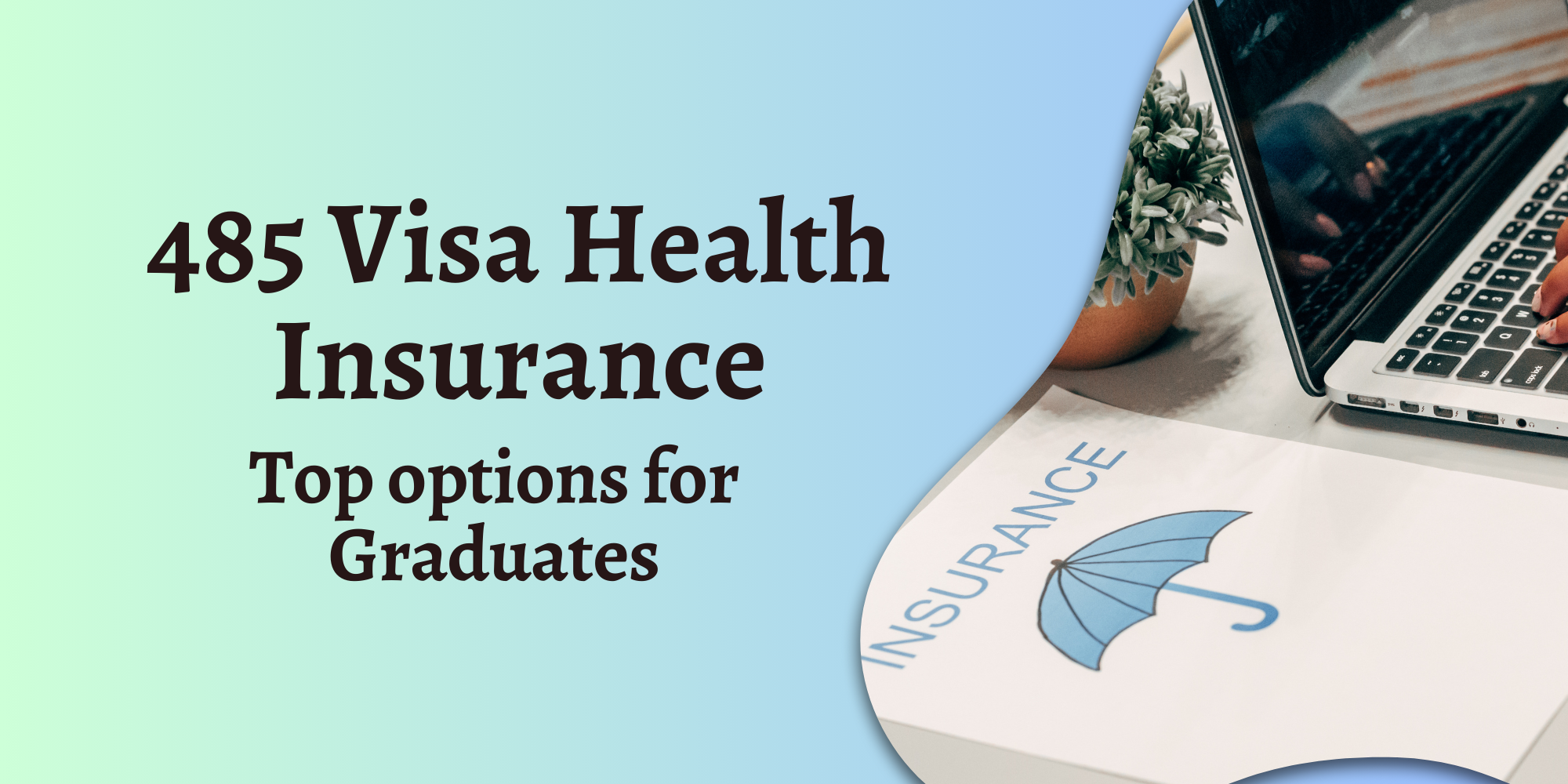Have you just graduated and plan to stay in Australia on a 485 visa? Getting the right health insurance plays a key role in your next steps. 485 visa health insurance doesn’t just meet a must-have rule – it also makes sure you can get good healthcare while you’re here. As you move from being a student to starting your career, knowing your insurance choices becomes key to protect your health and wallet.
This guide will help you navigate the world of health insurance for 485 visa holders. You’ll discover the best providers offering coverage that fits your needs, from cheap plans to all-inclusive options. We’ll also look at the differences between single and family coverage, show you how to pick the right plan, and talk about moving from Overseas Student Health Cover (OSHC) to 485 visa health insurance. By the time you finish reading, you’ll know how to choose the best healthcare coverage in Australia.
Understanding the 485 Visa Health Insurance Requirement
What is a 485 Visa?
The 485 visa, a temporary visa, lets recent graduates live, work, and study in Australia after they finish their studies. This visa gives you a chance to get valuable work experience and boost your career prospects in Australia.
Why do you need health insurance?
You must have health insurance as a 485 visa holder because you’ll pay for all your health costs in Australia. Australia’s national health scheme (Medicare) won’t cover you unless your country has a reciprocal health care agreement with Australia. This rule makes sure you can access needed medical care without facing big money troubles.
What does the Department of Home Affairs require?
The Department of Home Affairs has set rules for 485 visa health insurance:
- Visa condition 8501: The government will grant your 485 visa with this condition. It requires you to get a minimum level of health insurance before they grant the visa.
- Coverage duration: You must keep this insurance for you and your family during your whole time in Australia.
- Proof of insurance: When you apply for a 485 visa, you need to show proof that you’ve got an insurance policy that meets the minimum coverage rules. This means a letter or certificate from an insurance company.
- Minimum coverage: Your insurance must cover benefits equal to:
- Treatments in public hospitals
- A private patient’s stay in a public hospital
- Prostheses implanted
- Services for emergency ambulances
- Following the rules: Your visa might get canceled if you stop your policy or don’t stick to the OVHC rule. This could also hurt your chances of getting visas in the future.
- Signing up for Medicare: You might be able to ask for an exception from the OVHC rule if a reciprocal health care agreement covers you and you’ve joined Medicare. Right now, Australia has deals with several countries, including New Zealand, the United Kingdom, and Ireland.
- Medicare Levy Surcharge (MLS): The MLS might apply to you if you hold a 485 visa, earn a high income, are considered an Australian resident for tax purposes, and have signed up for Medicare. This extra charge affects Australian taxpayers who don’t have private hospital insurance. It ranges from 1% to 1.5% of your income.
To make sure you meet all requirements and have enough coverage, you need to research and pick a suitable health insurance plan. Keep in mind that having valid health insurance isn’t just something the law requires, but it’s also necessary to protect your health and finances while you’re in Australia.

Top Health Insurance Providers for 485 Visa Holders
When you’re searching for health insurance to meet your 485 visa requirements, you have quite a few options to consider. Let’s take a look at some of the main providers and what they offer.
Comparison of leading providers for 485 Visa Insurance
| OVHC Australia Group | This provider has a selection of policies made for 485 visa holders. They give options for both single and family plans, so you can find coverage that fits what you need. |
| GetMyPolicy | This site lets you compare several subclass 485 insurance providers in one spot. You can check how different policies stack up in terms of what they offer and how much they cost |
| Bupa | Bupa provides Overseas Visitor Health Cover (OVHC) for 485 Temporary Graduate Visa holders. Their coverage works across Australia and meets what the Department of Home Affairs requires. |
Key features to consider
When picking your 485 visa health insurance, think about these crucial features:
| Visa compliance | Make sure the policy meets what the Department of Home Affairs needs for condition 8501 |
| Coverage options | Search for plans that give both in-hospital and out-of-hospital coverage. |
| Extras | Some policies have added benefits like dental, optical, and physiotherapy coverage |
| Australia-wide coverage | Check that your insurance works across the whole country |
| Flexibility | Some providers let you pay premiums , unlike OSHC which needs upfront payment for your entire stay |
Pricing structures
Insurance providers offer tiered pricing structures to fit different needs and budgets. Here’s an example of pricing tiers from a top provider:
| Plans | Cost | Inclusions |
| Budget Working Cover | Starting at AUD 102.22 with an AUD 769.77 hospital excess | This plan costs the least while meeting visa requirements. |
| Standard Working Cover | Starting at AUD 175.28 with an AUD 769.77 hospital excess. | This plan covers in-hospital and out-of-hospital care, including visits to local doctors, specialists, and prescription drugs. |
| Mid Working Cover | Starting at AUD 282.81 with an AUD 769.77 hospital excess. | This plan covers in-hospital and out-of-hospital care plus some extras like basic dental and eye care. |
| Top Working Cover | Starting at AUD 531.29 monthly with an AUD 769.77 hospital excess. | This plan offers the widest range of benefits, covering major dental work, eye care, physical therapy, and hearing devices. |
The prices can change depending on things like how old you are and how much you earn. Some companies give discounts to younger people and look at your household’s taxable income to work out the right Australian government rebate.
When you’re picking your 485 visa health insurance, it’s essential to look at different companies and plans. Think about your specific health needs, how much you can spend, and what level of coverage you need to meet visa rules. Feel free to contact companies to talk about what you need and make sure you’re getting the best deal for your situation.
Budget-Friendly Insurance Options
When you’re hunting for 485 visa health insurance that’s easy on your wallet, you’ve got a few choices to think about. These budget-friendly plans can help you tick off your visa boxes while keeping your spending in check.
Basic hospital cover
The cheapest pick for 485 visa health insurance is a basic hospital cover plan. This kind of coverage often includes:
- Private and public hospital cover
- Ambulance cover
- A visa compliance letter
For example, some companies provide a “Budget” plan, which is their cheapest hospital cover that meets 485 visa requirements. This plan has a higher excess, like AUD 769.77 per year, which helps lower your premium. You’ll need to pay this excess if you go to the hospital before your health insurance benefits start.
Cheap extras
While basic hospital cover fulfills your visa needs, you might want to look at plans that offer more without costing much more. Some companies offer mid-range plans that include:
- Visits to the doctor (GP)
- Coverage for prescription drugs
- Basic dental and eye care benefits
These extra perks can assist you in handling everyday health needs without shelling out a lot of money.
How to cut down on premiums
To trim your insurance expenses even more, think about these approaches:
- Compare providers: Check out comparison websites to see many subclass 485 insurance providers at once. This helps you look at features and prices side by side to get the best deal.
- Pick a higher excess: Going for a higher excess can cut your premium a lot. Just make sure you can pay this amount if you end up needing hospital care.
- Check for age-based discounts: Some companies give discounts based on how old you are, which can bring down what you pay.
- Think about your income: Some insurers look at your household’s taxable income to work out the right Australian government rebate, which might lower your costs.
- Look into telehealth choices: Some plans offer free appointments with online GPs, which can cut down on your doctor visit costs.
- Take note of waiting periods: If you’re moving from another policy, search for insurers that will count waiting periods you’ve already completed on a similar cover.
While finding a cheap option is key, make sure your plan meets the Department of Home Affairs rules for condition 8501. Look for providers offering 100% visa-compliant covers that give you your Visa Certificate fast after approval.
By thinking through these budget-friendly choices and money-saving tricks, you can find a 485 visa health insurance plan that fits your needs without breaking the bank.

Comprehensive Coverage Plans
When you want to find extensive health insurance coverage for your 485 visa comprehensive plans give you a bunch of benefits to protect your health and well-being while you’re in Australia. These plans do more than just meet the basic needs giving you peace of mind and letting you use a wide range of healthcare services.
Full hospital cover
Comprehensive plans have full hospital cover, which you need to meet your visa health insurance requirements. This cover gives you:
- Unlimited emergency ambulance services across Australia
- The ability to use both public and private hospitals
- Cover for hospital stays and medical treatment for services in your plan
Full hospital cover gives you peace of mind. It protects you when unexpected health issues or accidents happen. This cover helps cut down the money you’d spend on hospital stays and medical treatments.
Lots of extras
Besides hospital cover complete plans often have many extras to help you take care of your everyday health. These extras might include:
- Money for doctor (GP) visits, including no extra costs for telehealth GP appointments on some plans
- Help paying for prescription drugs
- Dental care covering both small and big dental work
- Benefits for eye care and glasses or contacts
- Physical therapy and other health services
These extras can cut down your costs for everyday medical services helping you stay healthy more while living in Australia.
Extra perks
All-inclusive insurance plans often come with extra perks that boost your overall healthcare experience:
- Visa compliance: These plans follow all visa rules, including those for visas 407, 408, 457, 485, and 489.
- Quick visa health insurance certificate: When you buy online, you get your visa health insurance certificate , which makes the visa application process easier.
- Options: Many companies offer different levels of coverage, so you can pick a plan that fits what you need and can afford.
- Help when you need it: Good companies provide great customer service, with staff who know their stuff and can talk to you about what you need by phone, email, or online chat.
- Comparison tools: Some platforms let you compare several subclass 485 insurance providers in one spot helping you make a smart choice based on features and cost.
When you pick a full coverage plan, you’re not just meeting visa rules. You’re also putting money into your health while you’re in Australia. These plans give you wide protection against surprises. This lets you focus on your studies or job without stress about possible health costs.
Single vs. Family Coverage Choices
When you pick 485 visa health insurance, you can choose single or family coverage. Each type of plan has different perks and features to match what you need.
Single policy perks
For those living alone in Australia, a single policy might be your best bet. These plans are tailored to one person and cost less than family options. Single policies for 485 visa holders need to meet the Home Affairs Department’s rules, which include:
- Hospital stays and medical care coverage
- Unlimited emergency ambulance services
- Access to public and private hospitals
Some companies offer extra perks like doctor (GP) visit coverage, including no out-of-pocket costs for telehealth GP appointments on certain plans. This can help with everyday health needs.
Dual family policy features
If you’re in Australia with a partner, a dual family policy might suit you better. These policies cover two people and have an influence on more areas than single policies. Key features of dual family policies include:
- Coverage for both primary and secondary visa applicants
- Shared benefits to treat hospital and medical conditions
- Chance to add extras like dental and optical coverage
The 485 visa health cover requirements stay the same for both primary and secondary applicants. Make sure your chosen policy meets these requirements for both people.
Multi-family policy advantages
For those with kids or dependents multi-family policies offer the most complete coverage. These policies include:
Here’s what you get with family health insurance:
- The main person, their partner, and kids all get coverage
- Everyone in the family shares the benefits
- You might get more extras, like dental, eye care, and physio treatments
Family plans often give you more bang for your buck when you’re covering several people, but they cost more overall than single or couple plans.
When you pick your 485 visa health insurance, think about your situation and health needs. All plans must meet the basic rules set by the Home Affairs Department, but the amount of coverage can be quite different. You can pick from basic, medium, or top-level plans, each with its own mix of benefits and costs.
No matter what type of policy you pick, you’ll have to pay for any health care bills you rack up in Australia. It’s essential to look over policy specifics and ask for clear financial info before you say yes to any treatment. This way, you’ll know all about costs and coverage limits.

How to Pick the Right 485 Visa Health Insurance
Choosing the best 485 visa health insurance is key for your time in Australia. To make a smart choice, you need to think about several things and take a close look at what’s out there.
Figuring out your healthcare needs
Before picking a policy, you should check what healthcare you need. Think about how old you are how healthy you are now, and any health problems you already have. This check will help you figure out how much coverage you need. You’ll have to pay for any health care bills you get in Australia, so it’s crucial to have enough coverage.
Comparing policies
When you look at different 485 visa health insurance policies, think about these things:
- Coverage choices: Plans go from basic hospital coverage to full packages that add extras like dental and eye care.
- Costs of premiums: Look at premiums from different insurers. The least expensive plan isn’t always your best bet if it doesn’t fit what you need.
- Deductibles and co-pays: Get to know how much you’ll have to pay yourself for medical services.
- Waiting times: Look into any waiting periods for certain benefits for health issues you already have.
- Network of providers: Make sure the plan lets you see a wide variety of healthcare providers.
You can use online comparison tools to check out multiple subclass 485 insurance providers at once. This helps you to look at features and prices.
Reading the fine print
Before you make your final decision, take time to review the policy details. Keep an eye out for:
- Exclusions: Know what the policy doesn’t cover.
- Benefit limits: Check if there are any caps on coverage for specific treatments or services.
- Claim process: Learn how to submit claims and what paperwork you need.
- Portability: See if you can switch between Australian-based insurers without starting new waiting periods.
- Visa compliance: Make sure the policy meets the Department of Home Affairs requirements for condition 8501.
That all policies must meet basic requirements, but coverage can be quite different. Pick a policy that fits your health needs and budget giving you peace of mind while you’re in Australia.
Switching from OSHC to 485 Visa Health Insurance
When you change from being an international student to a temporary graduate in Australia, you’ll need to switch from your Overseas Student Health Cover (OSHC) to a health insurance plan that meets your new visa’s requirements. This change is essential to make sure you have enough health coverage and follow visa rules.
Main differences
When you change from OSHC to 485 visa health insurance, also called Overseas Visitor Health Cover (OVHC), you’ll see some key differences:
- Payment structure: OSHC requires you to pay for your entire stay upfront. OVHC, on the other hand, often lets you pay premiums each month, giving you more flexibility.
- Coverage options: OVHC plans are made to meet the specific needs of working visa holders. They cover hospital stays, medical treatments, and emergency ambulance services.
- Visa compliance: OVHC plans are designed to meet the Department of Home Affairs’ rules for the 485 visa, making sure you follow visa condition 8501.
When to make the switch
Picking the right moment matters when you change from OSHC to 485 visa health insurance. Here’s what you should take noe.
- If your OSHC remains valid when you submit your 485 visa application: you can include proof of your current OSHC as part of your visa paperwork.
- If your student visa and OSHC are coming to an end: you need to get OVHC starting the day after your OSHC ends. This keeps your health coverage unbroken and makes sure you follow visa rules.
- If you think you’ll get a decision on your visa application before your student visa runs out, you can hold off until the Department of Home Affairs gets in touch with you to provide evidence of suitable health cover for your new visa.
Potential pitfalls
To steer clear of problems during this shift, keep these possible snags in mind:
- Coverage gaps: Make sure you don’t have a gap between when your OSHC ends and your new OVHC starts. If you have a break in coverage, you might break your visa rules and risk having your visa canceled.
- Misunderstanding requirements: Be sure you know what health insurance you need for the 485 visa. The Department of Home Affairs says 485 visa holders must have good enough health insurance the whole time they’re in Australia.
- Overlooking visa condition 8501: This rule means you have to keep proper health insurance while you live in Australia. If you don’t follow this rule, you could lose your visa.
- Picking the wrong policy: Not all health insurance plans meet visa requirements. Make sure you choose a policy that complies with the Department of Home Affairs’ rules to meet visa condition 8501.
When you grasp these main ideas, you can switch from your student health cover to a suitable graduate cover without a hitch. This ensures you meet all visa rules and keep good health protection while you’re in Australia.
Pick your 485 visa health insurance with confidence
Getting the right health insurance for your 485 visa has a big effect on your time in Australia. It’s not just about meeting visa rules; it’s about feeling safe and having access to good healthcare during your stay. By looking at your choices, from cheap plans to full coverage, you can find a policy that suits your needs and budget.
Your health insurance needs change when you move from being on a student visa to a graduate in Australia. To get the most out of your stay, take some time to think about what health coverage you need, look at different plans, and pick one that gives you the right mix of protection and value for money. Once you have the right insurance, you can turn your attention to your career goals and enjoy Australia without stressing about surprise medical bills.

